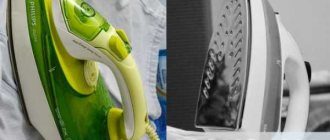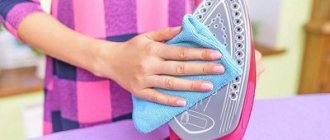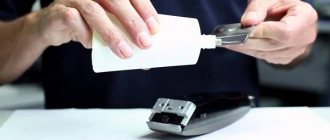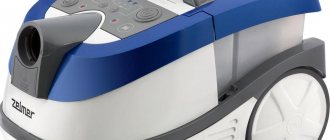Ironing process
Ironing should be done in a certain order. If you follow these steps, your clothes will remain crease-free:
- Pour filtered water. Tap liquid is not suitable as it leaves a residue behind.
- Set the desired mode with or without steam and place the device on the ironing board. The main thing is that it stands vertically. Otherwise things will burn.
- Place the clothes on the board. Next, you need to straighten it to avoid wrinkles.
- Iron the laundry on one side and turn it over to the other. Go through the iron again.
- After ironing, clothes should be hung on hangers, otherwise they will wrinkle.
- Turn off the device. Do not immediately put it in a box or other storage place. First you need to let the device cool down so that it does not burn other things.
Important! When ironing, you should not stay in one place for a long time. It is necessary to move the iron over the entire surface of the product. This will help smooth out wrinkles.
How to iron something that cannot be ironed?
Evening dresses are made from very delicate fabric, which, according to the label, cannot be ironed. But sometimes there is an urgent need to iron the product. To do this, you should try the following tips:
- Cover the soft pillow with a clean cloth, then lay out clothes made of delicate fabric, turned inside out and place a damp cloth on top.
- Iron at the lowest temperature, barely touching the fabric with the iron.
- After this, straighten the item and let it dry.
Important! You can also hang your clothes on hangers, and in a vertical position, using an iron, try to steam the delicate item.
What kind of water to fill
The instructions for using irons say that the water should be soft. But not everyone has a filter for cleaning. If it is not there, you can pour another water:
- distilled from the store - when ironing, you need to mix it with tap water and only then pour it into the device;
- special - also purchased water, but intended specifically for ironing.
The last option is best for ironing. The liquid is cleared of salt and harmful impurities. These elements can negatively affect the performance of the iron.
What types of irons are there?
Most irons that can be found on store shelves today are steam irons. Today everyone knows how to use a steam iron. Travel irons and irons with a steam generator are less common. In a steam iron, water is stored in a special chamber. From which it gets onto clothes through the sole with holes. These holes are located differently on different irons. Some models have a completely lattice base, others with holes on the spout or closer to the bottom. The better the water passes through the soleplate of the electric device, the better the item will be ironed. The most popular companies producing household appliances today are Tefal and Philips.
Irons come in medium and high power steam. For home use, of course, a regular iron is sufficient. But how should studio or hotel workers use an iron? It is better to give preference to more powerful models. There are also irons with a steam generator. It usually comes included with purchase and is equipped with a special boiler, which in turn will allow you to iron continuously for 1-1.5 hours. An iron with a steam generator is, of course, more expensive, but it is much easier and more economical to use.
What is prohibited to do
It is important to follow the rules for using the device at home. The standard operating instructions for the iron contain the following:
- Do not place in a sunny place. The rays negatively affect the device and lead to its wear.
- Do not leave the iron dirty. The device needs to be cleaned regularly. Do not use hard brushes or chemicals.
- Do not place near hard metal objects. They can lead to deformation of the housing.
You can simplify the ironing process if you use the device correctly. You also need to find good storage space. A special case is suitable that will protect the device from corrosion.
Subscribe to TechnoCouncil on social networks so you don’t miss anything:
How to use a steam iron correctly
Despite the fact that these devices are very convenient and easy to use, there are several features of the correct use of steam irons.
- When you start using the iron, do not direct the steam stream directly at the laundry, as the steam chamber of the new device may become dirty. Please note: you first need to pour water into the compartment, release a stream of steam, and then start ironing.
- You can only pour water into or out of the iron's reservoir if the appliance is unplugged. Don't neglect safety precautions.
- Experts strongly recommend that after ironing, empty the water from the device, set the iron handle to the “no steam” position and store the iron in an upright position in a cool place. What is this connected with? If you do not set the “no steam” mode, the remaining water will pour into the soleplate of the iron, which is best avoided.
Iron care
- It is best to use distilled water to protect the device from scale.
- Choose the right temperature. Otherwise, the fabric may stick to the soleplate of the iron, thereby ruining the item.
- To clean the sole of the device, choose gentle products. Never use objects that can scratch the sole.
Consider the characteristics of fabrics
- It is difficult to iron linen and clothes made of cotton and linen with high quality. Try not to over-dry such things. If they have a relief pattern or embroidery, the area can only be ironed from the reverse side.
- If ironing woolen clothes, the iron temperature should be moderate. This should be done through a damp cloth. Otherwise, things may become deformed, and there is also a danger of leaving iron marks on them. Knitted or knitted items with a raised pattern should not be ironed.
- Knitwear must be ironed carefully, without pressing. This should be done through a damp cloth. To iron such things, you will need the steaming function, which is found in all DeLonghi brand irons.
- If you are ironing corduroy, the iron should be barely warm. Experts advise ironing this fabric from the inside out.
- Viscose products should only be ironed dry. If you iron these items incorrectly, stains may occur.
- Silk items can only be ironed with a lukewarm iron and only from the inside out.
What else is important to know
- Before turning on the device, first of all, carefully read the instructions, make sure that the outlet into which you plug the device has the required voltage. The iron cord must not be damaged. If damage does occur, a fire or short circuit may occur.
- Only clean clothes need to be ironed. If there are stains on things, then when ironing they eat into the fabric. It is very difficult to remove them later.
- The soleplate of the iron can be easily cleaned with baking soda.
- Before you start ironing, be sure to find out at what temperature you can iron this or that item.
- You only need to iron things lengthwise. Thanks to this, they will not stretch or deform.
If you want your clothes to always be neat and beautiful, choose a DeLonghi iron as your assistant. With its help, you can quickly and easily iron any fabric. An iron from the DeLonghi brand is the key to careful and high-quality ironing!
delonghi-shop.com.ua
how to use an iron, ironing rules
.
Ironing things is not a complicated process, and thanks to the variety of technical devices, it has become even easier. In order for the item to retain its original shape and not lose color, you need to know how to use an iron and how to iron things correctly.
Some items require a special approach when ironing
Recommendations for proper ironing
Each item purchased has washing and ironing instructions on the tag. Ironing temperatures and steam tips vary depending on the material. Depending on the fabric, temperature conditions are provided:
- linen fabric can be ironed at a setting of one hundred and ninety degrees;
- cotton is ironed at a temperature of one hundred and sixty degrees, maximum one hundred and ninety;
- wool can also be ironed if the temperature is no more than one hundred and sixty-five;
- silk. the material is ironed at a temperature of up to one hundred and forty;
- viscose - eighty-five, the maximum you need is one hundred and fifteen degrees.
Before ironing, place your workspace comfortably so that the light falls on your left side if you iron with your right hand. You can iron clothes without using a board - on the table, laying a blanket or some kind of non-slip fabric on top.
To make the process faster and more efficient, point the iron from the right to the left. You need to start ironing from a wide area of clothing to a narrower area. To avoid deforming the material, ironing should begin along a line straight and perpendicular to the fabric. If the cut is diagonal, then ironing should be done along it.
Ironing rules suggest that if you pull the material, it can ruin the material and stretch it. Iron small areas first: sleeves, pockets and patterns on clothes. If the color of the fabric is dark, turn it inside out.
If it's a skirt or dress, you need to iron it from the top. Ironing is done parallel to the waistband of the skirt, and then from the bottom to the top. The fabric must be held so that the nose straightens the resulting folds.
How to properly iron clothes if they are made of rough fabric? Do not pull the item, carefully straightening the material along the seam. Before washing, corrugated clothes are passed through with threads and dried on a hanger, then ironing will not distort the condition of the fabric.
How to properly iron clothes if it is a business suit? It is better to put gauze on top of the suit, so that there will be no traces left from the iron on the clothes. The upper part of the suit is ironed in the following sequence: first the sleeves, then the rest of the parts. But first of all, you need to iron the lining of your jacket or jacket. The jacket is ironed under steam on a hanger; in this case, an iron is not needed.
To prevent the crease on your trousers from disappearing, you will have to iron them regularly. Turn the pants inside out and iron the seams and pockets. Iron starting from the bottom of the leg, pressing the edges with an ironing device. After this, switch to the belt on both sides, starting with the front one.
The shirt can be quickly ironed if it is damp. Usually people iron cuffs buttoned, but it is correct to iron them unbuttoned and straightened on the board, from the outside and inside.
You can quickly iron your sleeves by threading them through a small board, which is specifically needed for straightening hard-to-reach areas.
An item made from knitwear is ironed inside out, while still wet. Apply the iron, and do not smooth the material with it, and the fabric will not be deformed. Once the process is complete, place the clothes on a board to dry.
Pockets and creases on trousers need to be ironed carefully.
The difference in fabric care
Cotton products are straightened when wet. Moisturize faster with warm water, so it is absorbed faster. After moistening, fold the product into a roll so that it is completely moistened. To level the material, it is pulled by different edges. Large items, sheets or tablecloths, can be folded into four parts and straightened separately.
Silk fabrics are not hung on a rope but wrapped in a towel. Straighten them when wet and in a delicate mode. Do not splash water to avoid leaving stains.
Light silk is ironed on the front side, and other colors on the back side and a special material is applied. The main thing is not to press the fabric too hard and smooth the material at a low temperature.
The woolen material is turned inside out and smoothed in a delicate mode. Apply a damp cloth and iron, pressing only lightly. Not all wool items need to be ironed if hung on a hanger over steam. If things have shrunk, you need to spray water on them, let them lie down and iron them through a special material. When the item is ironed, it needs to be allowed to dry so that it does not shrink again.
If clothes are made of pile, they should be ironed without pressure and under gauze. The velvety material is hung over steam, then it straightens. It is not worth ironing.
You need to iron particularly delicate material after applying starch to the clothes and applying the iron carefully, trying not to leave wrinkles. Some inventive housewives sew lace onto white fabric and iron it through it.
Delicate fabrics should be ironed on a gentle setting.
How to disassemble an iron
The first difficulty faced by those who want to repair the iron themselves is disassembly. This is far from simple and obvious. The easiest way is to remove the back panel. There are several screws that are visible and are not difficult to unscrew. In addition to screws, there may be latches. So, having unscrewed all the visible fasteners, we pry up the cover with the tip of a screwdriver or an old plastic card, and separate the cover from the body.
Underneath there is a terminal block to which the cord is attached. If there are problems with the cord, you can no longer disassemble the iron. But if everything is fine with the cord, you will have to disassemble it further, and this may cause problems.
Some irons - Philips, Tefal - still have bolts under the cover. We also unscrew them. In general, if we see fasteners, we remove them.
Removing the back cover is the first thing to do when disassembling the iron.
Each manufacturer develops its own design, and it often changes from model to model. That is why difficulties arise. But there are several points that are found in almost any manufacturer.
You immediately need to remove the temperature control dial and the steam button, to do this you need to hold them in your fingers and pull them up. The buttons may have latches, so you may need something thin so that you can press them out a little - you can pry them off with a screwdriver.
To disassemble the iron you need to remove the buttons
Some irons, such as the Rowenta, as in the photo, have bolts on the handle (some Scarlet models have them). If there are any, unscrew them. There is also a screw hidden under the removed buttons; we unscrew that too. Then remove the top plastic parts. They are usually secured with snap locks. To make it easier to remove them, you can insert a knife blade or a piece of plastic (plastic card) into the lock.
There are usually a number of bolts under the covers. Having unscrewed them, we continue disassembling until the body and sole are separated. Unfortunately, it is impossible to give more precise recommendations - there are too many different designs. What can be advised is to act slowly and carefully. And several videos on how to disassemble irons of different brands.











